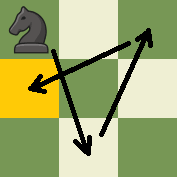24
2
In Chess, a Knight on grid (x, y) may move to (x-2, y-1), (x-2, y+1), (x-1, y-2), (x-1, y+2), (x+1, y-2), (x+1, y+2), (x+2, y-1), (x+2, y+1) in one step. Imagine an infinite chessboard with only a Knight on (0, 0):
How many steps is required for moving a Knight from (0, 0) to (tx, ty)?
Inputs
Two integers: tx, ty;
-100 < tx < 100, -100 < ty < 100
Output
Minimal steps needed to move a Knight from (0, 0) to (tx, ty).
Rules
- code golf
Testcases
x y -> out
0, 0 -> 0
0, 1 -> 3
0, 2 -> 2
1, 1 -> 2
1, 2 -> 1
3, 3 -> 2
4, 0 -> 2
42, 22 -> 22
84, 73 -> 53
45, 66 -> 37
99, 99 -> 66
-45, -91 -> 46
-81, 1 -> 42
11, -2 -> 7
document.write('<div>');[..."EFEDEDCDCBCBCBCBCBCBCBCBCBCBCBCBCBCDCDEDEFE;FEDEDCDCBCBABABABABABABABABABABABCBCDCDEDEF;EDEDCDCBCBABABABABABABABABABABABABCBCDCDEDE;DEDCDCBCBABA9A9A9A9A9A9A9A9A9A9ABABCBCDCDED;EDCDCBCBABA9A9A9A9A9A9A9A9A9A9A9ABABCBCDCDE;DCDCBCBABA9A9898989898989898989A9ABABCBCDCD;CDCBCBABA9A989898989898989898989A9ABABCBCDC;DCBCBABA9A98987878787878787878989A9ABABCBCD;CBCBABA9A9898787878787878787878989A9ABABCBC;BCBABA9A989878767676767676767878989A9ABABCB;CBABA9A98987876767676767676767878989A9ABABC;BABA9A9898787676565656565656767878989A9ABAB;CBA9A989878767656565656565656767878989A9ABC;BABA98987876765654545454545656767878989ABAB;CBA9A987876765654545454545456567678789A9ABC;BABA98987676565454343434345456567678989ABAB;CBA9A987876565454343434343454565678789A9ABC;BABA98987676545434323232343454567678989ABAB;CBA9A987876565434323232323434565678789A9ABC;BABA98987676545432341214323454567678989ABAB;CBA9A987876565434321232123434565678789A9ABC;BABA98987676545432323032323454567678989ABAB;CBA9A987876565434321232123434565678789A9ABC;BABA98987676545432341214323454567678989ABAB;CBA9A987876565434323232323434565678789A9ABC;BABA98987676545434323232343454567678989ABAB;CBA9A987876565454343434343454565678789A9ABC;BABA98987676565454343434345456567678989ABAB;CBA9A987876765654545454545456567678789A9ABC;BABA98987876765654545454545656767878989ABAB;CBA9A989878767656565656565656767878989A9ABC;BABA9A9898787676565656565656767878989A9ABAB;CBABA9A98987876767676767676767878989A9ABABC;BCBABA9A989878767676767676767878989A9ABABCB;CBCBABA9A9898787878787878787878989A9ABABCBC;DCBCBABA9A98987878787878787878989A9ABABCBCD;CDCBCBABA9A989898989898989898989A9ABABCBCDC;DCDCBCBABA9A9898989898989898989A9ABABCBCDCD;EDCDCBCBABA9A9A9A9A9A9A9A9A9A9A9ABABCBCDCDE;DEDCDCBCBABA9A9A9A9A9A9A9A9A9A9ABABCBCDCDED;EDEDCDCBCBABABABABABABABABABABABABCBCDCDEDE;FEDEDCDCBCBABABABABABABABABABABABCBCDCDEDEF;EFEDEDCDCBCBCBCBCBCBCBCBCBCBCBCBCBCDCDEDEFE"].forEach(c=>document.write(c==';'?'<br>':`<span class="d-${c}">${c}</span>`));
document.write('<style>body{line-height:16px;color:rgba(255,255,255,0.2);}span{display:inline-block;width:16px;font-size:16px;text-align:center;}div{white-space:pre;}');[...'0123456789ABCDEF'].map((c,i)=>document.write(`.d-${c}{background:hsl(${60-4*i},80%,${65-2*i}%)}`));Related OEIS
Here are some OEIS for further reading
- A018837: Number of steps for knight to reach (n,0) on infinite chessboard.
- A018838: Number of steps for knight to reach (n,n) on infinite chessboard.
- A065775: Array T read by diagonals: T(i,j)=least number of knight's moves on a chessboard (infinite in all directions) needed to move from (0,0) to (i,j).
- A183041: Least number of knight's moves from (0,0) to (n,1) on infinite chessboard.
![ArrayPlot@Array[GraphDistance[KnightTourGraph@@({x,y}=Abs@{##}+5),2y+3,(x-2)y-2]&,{65,65},-32]](../../I/static/images/9148c1ef3d2d192ba80109f7b8abed50b2ac39609e7166ffec43da82b88cc7ac.jpg)


You may take a reference of the formula given in https://oeis.org/A065775
– tsh – 2018-04-27T12:18:47.9032Can I take input as a complex number
x+yi? – Lynn – 2018-04-27T14:43:18.0671@lynn i think it is acceptable. – tsh – 2018-04-27T14:52:15.123
@user202729 updated the code snippet to show the result. – tsh – 2018-04-28T01:50:11.383
A very fine map. – Willtech – 2018-04-29T03:48:41.093